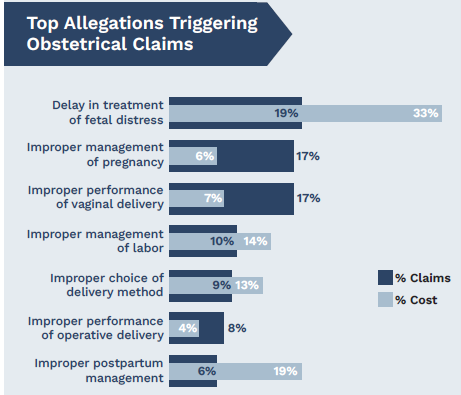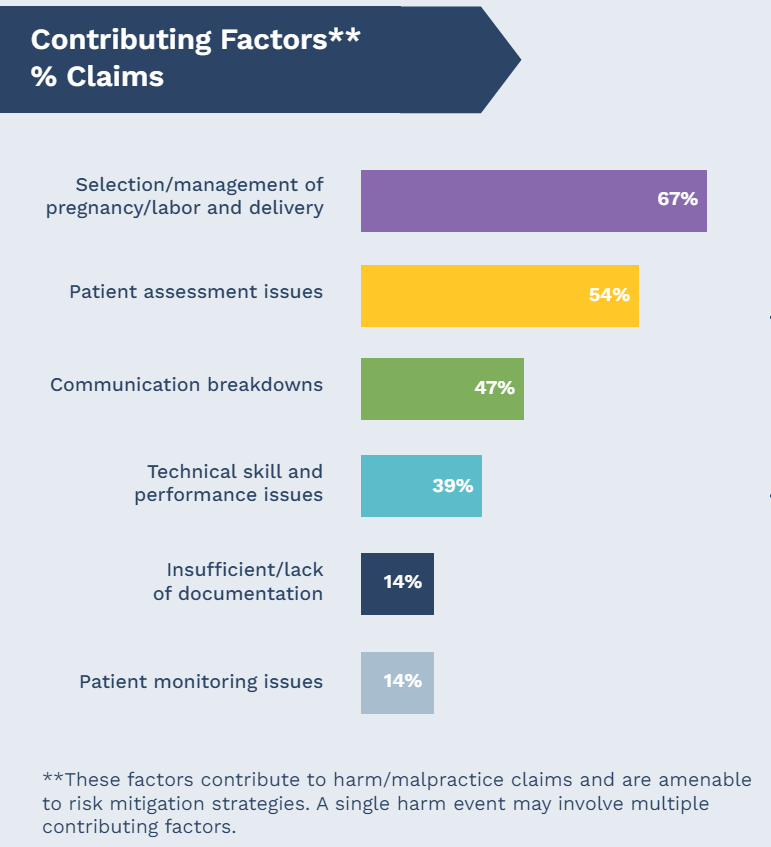Five Steps to Reduce Obstetrical Errors and Malpractice Claims
Failure to respond appropriately responds in dire outcome
A young woman with an uncomplicated pregnancy was examined by an obstetrician (OB) for a repeat cesarean delivery. The OB performed the cesarean delivery without incident at 10:00 a.m. and then left the hospital to drive to a nearby town to see patients. After being transferred from the recovery room to the postpartum unit around noon, the woman began complaining of abdominal pain and passed two softball-sized blood clots. Her nurse called the OB and reported the woman’s condition. The OB ordered medications to control the bleeding.

Over the next several hours, the nurses called the OB multiple times reporting that the woman was continuing to bleed. During this time, the OB ordered six more injections of Hemabate and an IV infusion of Lactated Ringers with Pitocin. The OB then ordered two units of packed red blood cells (RBCs) because the woman’s hemoglobin was 5.8. The nurse hung the first unit at 4:00 p.m. By 5:30 p.m., despite the two units of packed RBCs, the woman’s blood pressure was dropping, and the nursing notes described her as very pale, restless, and continuing to complain of abdominal pain. At 6:45 p.m., the woman became unresponsive and went into cardiopulmonary arrest. A code was called, but resuscitation was unsuccessful, and the woman died. The autopsy concluded the cause of death was exsanguination.
Her family later filed a malpractice claim against the OB and the hospital, alleging improper management of a postpartum patient, resulting in death. The experts who reviewed the case were critical of the hospital nurses for failing to escalate the case up the chain of command when the woman continued to bleed and the OB managing the patient by phone only. They were also critical of the hospital’s lack of a massive transfusion protocol in response to OB hemorrhage. The experts were also critical of the OB for failing to order a complete blood count (CBC) earlier to evaluate the woman’s hemoglobin and hematocrit, for failing to respond to repeated calls from the nursing team about the continued bleeding, and for failing to call in a surgical consult to place sutures in the uterus when the bleeding continued despite measures to stop it. The malpractice claim was settled with payment to the family on behalf of the hospital and the OB.
Top allegations and responsible clinicians
The number one allegation triggering OB claims is a delay in the recognition and treatment of fetal distress. This significant allegation accounts for 19% of OB claims and 33% of costs. The second most costly allegation is improper postpartum management, which represents only 6% of OB claims.


Both charts reflect former Constellation, Inc. claims reviewed 12/31/2021
Forty-five percent of OB claims involved a secondary responsible healthcare professional, and almost half of those claims involved nursing and an alleged delay in recognition and treatment of fetal distress. This highlights a gap in fetal monitoring and team communication skills.
What contributes to obstetrical harm and malpractice claims?
Knowing the contributing factors involved in OB harm events helps clinicians, care teams, and healthcare organizations develop strategies to reduce risk.
The number one contributing factor is issues with clinical judgment in the selection or management of pregnancy/delivery. As this case illustrates, the second and third most frequent contributing factors are patient assessment issues and breakdowns in communication.

Former Constellation, Inc. claims reviewed 12/31/2021
Five steps to reduce obstetrical harm
- Provide joint physician and nursing team training using a comprehensive, evidence-based electronic fetal heart rate monitoring education program.
- Perform simulation drills on low-frequency, high-severity events (e.g., postpartum hemorrhage).
- Implement evidence-based Maternal Patient Safety Bundles to guide practice.
- Invest in team training and communication skills. Watch our on-demand webinars and use tools such as SBAR and I-PASS.
- Analyze your harm events using an all-cause or root-cause analysis tool to identify the contributing factors and implement risk strategies to mitigate future adverse events.
Virtual conference: Working Together to Improve Patient Outcomes
Curi and Iowa Healthcare Collaborative are coming together to offer a virtual conference highlighting the impact that harm events from the top drivers of malpractice claims—diagnostic error, surgical treatment, and obstetrical treatment—have for physicians, healthcare providers, organizations, and patients. Attendees will gain valuable insights to understand why these malpractice allegations occur, identify opportunities for improvement, and recognize how early intervention provides a better way forward for all involved after harm.
There is no fee to register, and continuing education credits will be available.
Risk reports
Our risk reports analyze malpractice claim data on a wide range of topics and specialties and share insights clinicians, care teams, clinics, hospitals, and senior living organizations can use to help reduce harm events and malpractice claims.
Are you a client? Sign in to MyAccount to access exclusive client versions of our risk reports. The expanded reports share actionable insights and strategies that you can utilize to help reduce harm events and malpractice claims. After you sign in, follow Risk Resources > Tools & Resources > Publications > Risk Reports. You also have access to a host of Bundled Solutions (in Risk Resources) that cover a wide variety of topics—such as Obstetrics—to assist you in your risk mitigation efforts.
Curi’s risk mitigation resources and guidance are offered for educational and informational purposes only. This information is not medical or legal advice, does not replace independent professional judgment, does not constitute an endorsement of any kind, should not be deemed authoritative, and does not establish a standard of care in clinical settings or in courts of law. If you need legal advice, you should consult your independent/corporate counsel. We have found that using risk mitigation efforts can reduce malpractice risk; however, we do not make any guarantees that following these risk recommendations will prevent a complaint, claim, or suit from occurring, or mitigate the outcome(s) associated with any of them.
Share this blog article:
Latest Blog Articles
Five Steps to Reduce Generative AI Risks in Healthcare
AI is already assisting physicians and healthcare organizations in many ways. Learn how its use may impact liability and what strategies can mitigate risk.
Five Steps to Reduce Obstetrical Errors and Malpractice Claims
Learn how to reduce obstetrical harm using evidence-based protocols for managing high-risk situations, joint team fetal monitoring education, and enhanced teamwork.
How to Reduce Surgical Harm and Malpractice Claims
In an analysis of our medical professional liability claims, surgical allegations are #1 in occurrence and #2 in cost. Learn how to reduce surgical malpractice risk.



